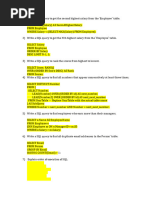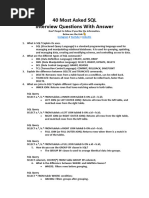0 ratings0% found this document useful (0 votes)
33 viewsBasic SQL For Data Analyst Interview Questions
Uploaded by
Mr. dev kumarCopyright
© © All Rights Reserved
We take content rights seriously. If you suspect this is your content, claim it here.
Available Formats
Download as PDF, TXT or read online on Scribd
0 ratings0% found this document useful (0 votes)
33 viewsBasic SQL For Data Analyst Interview Questions
Uploaded by
Mr. dev kumarCopyright
© © All Rights Reserved
We take content rights seriously. If you suspect this is your content, claim it here.
Available Formats
Download as PDF, TXT or read online on Scribd
You are on page 1/ 10
Basic SQL For Data Analyst Interview Questions
1. What is SQL, and what is its purpose in data analysis?
SQL (Structured Query Language) is a standard language for
managing and manipulating relational databases. It allows analysts to
query, update, and manage data effectively, which is crucial for data
analysis tasks.
2. How do you retrieve all columns from a table named sales?
Example: "SELECT * FROM sales;"
3. Write a SQL query to select distinct values from a column
named product_category.
Example: "SELECT DISTINCT product_category FROM sales;"
4. How do you filter records in SQL? Provide an example.
Use the WHERE clause to filter records based on specific conditions.
Example: "SELECT * FROM sales WHERE amount > 1000;"
5. Explain the GROUP BY clause and provide an example.
The GROUP BY clause is used to aggregate rows that have the same
values in specified columns.
Example: "SELECT product_category, SUM(amount) FROM sales
GROUP BY product_category;"
6. What is the purpose of the HAVING clause? How does it differ
from WHERE?
HAVING is used to filter groups after aggregation, while WHERE filters
rows before aggregation.
Example: "SELECT product_category, SUM(amount) FROM sales
GROUP BY product_category HAVING SUM(amount) > 5000;"
7. How do you sort the results of a query?
Use the ORDER BY clause to sort results in ascending or descending
order.
Example: "SELECT * FROM sales ORDER BY amount DESC;"
8. Write a query to find the total sales amount for each product.
Example: "SELECT product_name, SUM(amount) FROM sales GROUP
BY product_name;"
9. What is the difference between INNER JOIN and LEFT JOIN?
INNER JOIN returns rows with matching values in both tables,
while LEFT JOIN returns all rows from the left table and matched
rows from the right table, with unmatched rows from the right table
filled with NULLs.
• INNER JOIN Example: "SELECT sales.product_name,
products.price FROM sales INNER JOIN products ON
sales.product_id = products.product_id;"
• LEFT JOIN Example: "SELECT sales.product_name,
products.price FROM sales LEFT JOIN products ON
sales.product_id = products.product_id;"
10. How do you find the top 5 highest sales amounts?
Example: "SELECT amount FROM sales ORDER BY amount DESC LIMIT
5;"
Medium SQL Question for Data Analyst Interview
11. What is a subquery, and how can you use it in
the WHERE clause?
A subquery is a query within another query used to perform
operations based on the results of the outer query.
Example: "SELECT product_name FROM sales WHERE amount >
(SELECT AVG(amount) FROM sales);"
12. Explain the concept of a CROSS JOIN.
A CROSS JOIN returns the Cartesian product of two tables, where
each row in the first table is combined with each row in the second
table.
Example: "SELECT * FROM products CROSS JOIN categories;"
13. How do you calculate the average of a column?
Use the AVG() function to calculate the average value.
Example: "SELECT AVG(amount) FROM sales;"
14. What is the purpose of the COUNT() function? Provide an
example.
The COUNT() function returns the number of rows that match a
specified condition.
Example: "SELECT COUNT(*) FROM sales WHERE product_category =
'Electronics';"
15. Write a query to find the minimum and maximum sales
amounts.
Example: "SELECT MIN(amount) AS MinAmount, MAX(amount) AS
MaxAmount FROM sales;"
16. How do you update records in a table?
Use the UPDATE statement to modify existing records.
Example: "UPDATE sales SET amount = amount * 1.1 WHERE
product_name = 'Laptop';"
17. Explain the CASE statement and provide an example.
The CASE statement allows for conditional logic in SQL queries.
Example: "SELECT product_name, CASE WHEN amount > 1000 THEN
'High' ELSE 'Low' END AS sales_category FROM sales;"
18. How do you handle NULL values in SQL queries?
Use functions like IS NULL, IS NOT NULL, or COALESCE() to handle
NULL values.
Example: "SELECT COALESCE(discount, 0) FROM sales;"
19. What is the LIMIT clause used for? Provide an example.
The LIMIT clause restricts the number of rows returned by a query.
Example: "SELECT * FROM sales LIMIT 10;"
20. How do you use the JOIN clause to combine data from multiple
tables?
Use JOIN to combine rows from two or more tables based on related
columns.
Example: "SELECT orders.order_id, customers.customer_name FROM
orders JOIN customers ON orders.customer_id =
customers.customer_id;"
21. What is a self-join? Provide an example.
A self-join is a join where a table is joined with itself. It is useful for
hierarchical data.
Example: "SELECT e1.employee_name AS Employee,
e2.employee_name AS Manager FROM employees e1 LEFT JOIN
employees e2 ON e1.manager_id = e2.employee_id;"
22. Explain the UNION and UNION ALL operators.
UNION combines the results of two queries and removes
duplicates. UNION ALL combines results without removing
duplicates.
• UNION Example: "SELECT product_name FROM sales UNION
SELECT product_name FROM returns;"
• UNION ALL Example: "SELECT product_name FROM sales
UNION ALL SELECT product_name FROM returns;"
23. How do you find duplicate records in a table?
Use the GROUP BY clause with HAVING COUNT(*) > 1 to find
duplicates.
Example: "SELECT product_name, COUNT(*) FROM sales GROUP BY
product_name HAVING COUNT(*) > 1;"
24. What is a window function? Provide an example.
Window functions perform calculations across a set of table rows
related to the current row, such as running totals or rankings.
Example: "SELECT product_name, amount, RANK() OVER (ORDER BY
amount DESC) AS rank FROM sales;"
25. How do you calculate a running total in SQL?
Use the SUM() window function with an appropriate OVER clause.
Example: "SELECT order_date, amount, SUM(amount) OVER (ORDER
BY order_date) AS running_total FROM orders;"
26. How do you use the EXISTS clause in SQL?
The EXISTS clause checks if a subquery returns any rows.
Example: "SELECT product_name FROM sales WHERE EXISTS (SELECT
* FROM returns
WHERE returns.product_id = sales.product_id);"
27. Explain the difference between WHERE and HAVING clauses.
WHERE filters rows before aggregation, while HAVING filters groups
after aggregation.
• WHERE Example: "SELECT * FROM sales WHERE amount >
1000;"
• HAVING Example: "SELECT product_name, SUM(amount) FROM
sales GROUP BY product_name HAVING SUM(amount) > 5000;"
28. How do you find the number of orders per customer?
Example: "SELECT customer_id, COUNT(order_id) FROM orders
GROUP BY customer_id;"
29. What is a TEMPORARY table, and how is it used?
A TEMPORARY table is a table that exists temporarily during a session
and is dropped automatically when the session ends.
Example: "CREATE TEMPORARY TABLE temp_sales AS SELECT * FROM
sales WHERE amount > 1000;"
30. How do you use the ALTER TABLE statement?
The ALTER TABLE statement modifies an existing table structure, such
as adding or dropping columns.
Example: "ALTER TABLE sales ADD COLUMN discount DECIMAL(10,
2);"
31. What is normalization, and why is it important?
Normalization is the process of organizing data to reduce redundancy
and improve data integrity. It ensures that the database is efficient
and maintains consistency.
32. How do you perform a bulk insert of data into a table?
Use the INSERT INTO ... VALUES statement with multiple values or a
bulk loading utility.
• Multiple values Example: "INSERT INTO sales (product_name,
amount) VALUES ('Laptop', 1200), ('Smartphone', 800);"
• Bulk load Example (MySQL): "LOAD DATA INFILE 'file_path.csv'
INTO TABLE sales FIELDS TERMINATED BY ',';"
33. Explain the concept of indexing and its benefits.
Indexing improves the speed of data retrieval operations on a table
by creating a data structure that allows quick lookups.
34. How do you create an index on a table?
Use the CREATE INDEX statement to create an index on one or more
columns.
Example: "CREATE INDEX idx_product_name ON
sales(product_name);"
Hard SQL Question For Data Analyst Interview Questions
35. What are some common performance optimization techniques
in SQL?
Common techniques include using indexes, optimizing queries,
reducing the use of subqueries, and ensuring efficient joins.
36. How do you use the EXPLAIN statement to analyze query
performance?
The EXPLAIN statement provides information about how a query is
executed, including the order of operations and the use of indexes.
Example: "EXPLAIN SELECT * FROM sales WHERE amount > 1000;"
37. What is the purpose of the COALESCE() function?
The COALESCE() function returns the first non-NULL value from a list
of arguments.
Example: "SELECT COALESCE(discount, 0) FROM sales;"
38. How do you calculate the percentage of total sales for each
product?
Use a combination of SUM() and a window function to calculate
the percentage.
Example: "SELECT product_name, SUM(amount) AS total_sales,
(SUM(amount) / SUM(SUM(amount)) OVER ()) * 100 AS percentage
FROM sales GROUP BY product_name;"
39. What is a VIEW, and how do you create one?
A VIEW is a virtual table based on the result of a query. It simplifies
complex queries and enhances security.
Example: "CREATE VIEW high_value_sales AS SELECT * FROM sales
WHERE amount > 1000;"
40. How do you use the DROP TABLE statement?
The DROP TABLE statement deletes an entire table and its data from
the database
Example: "DROP TABLE old_sales;"
41. What is the difference between DELETE and TRUNCATE?
DELETE removes rows from a table based on a condition and can be
rolled back, while TRUNCATE removes all rows from a table and
cannot be rolled back.
• DELETE Example: "DELETE FROM sales WHERE amount < 500;"
• TRUNCATE Example: "TRUNCATE TABLE sales;"
42. How do you find the median value of a column in SQL?
Finding the median requires sorting and using window functions.
Example: "WITH OrderedSales AS (SELECT amount, ROW_NUMBER()
OVER (ORDER BY amount) AS rn, COUNT(*) OVER () AS total_count
FROM sales) SELECT AVG(amount) AS median FROM OrderedSales
WHERE rn IN ((total_count + 1) / 2, (total_count + 2) / 2);"
43. What is the RANK() function, and how is it used?
The RANK() function assigns a rank to each row within a partition of
the result set, with gaps in rank values if there are ties.
Example: "SELECT product_name, amount, RANK() OVER (ORDER BY
amount DESC) AS rank FROM sales;"
44. How do you perform a JOIN with multiple tables?
You can join more than two tables by chainingJOIN operations.
Example: "SELECT orders.order_id, customers.customer_name,
products.product_name FROM orders JOIN customers ON
orders.customer_id = customers.customer_id JOIN products ON
orders.product_id = products.product_id;"
45. What is a TEMPORARY table, and when would you use it?
A TEMPORARY table is used to store intermediate results temporarily
during a session, useful for complex queries or batch processing.
Example: "CREATE TEMPORARY TABLE temp_sales AS SELECT * FROM
sales WHERE amount > 1000;"
46. How do you retrieve the last N records from a table?
Use the ORDER BY clause with LIMIT to get the last N records.
Example: "SELECT * FROM sales ORDER BY sale_date DESC LIMIT 10;"
47. Explain the DATEPART() function with an example.
DATEPART() extracts a specific part (e.g., year, month) from a date.
Example: "SELECT DATEPART(year, sale_date) AS sale_year FROM
sales;"
48. How do you use JOIN to include rows with no match in one of
the tables?
Use a LEFT JOIN or RIGHT JOIN to include rows from one table even if
there are no matching rows in the other table.
Example: "SELECT employees.name, departments.department_name
FROM employees LEFT JOIN departments ON
employees.department_id = departments.department_id;"
49. How can you calculate the difference between two dates in
SQL?
Use date functions to calculate the difference between two dates.
Example: "SELECT DATEDIFF(day, start_date, end_date) AS
date_difference FROM projects;"
50. What is the difference between CHAR and VARCHAR data types?
CHAR is a fixed-length string, while VARCHAR is a variable-length
string. CHAR uses the specified length for all values, padding with
spaces if needed, whereas VARCHAR only uses the space needed for
each value.
You might also like
- Formal Report, Carboxylic Acid and Derivatives88% (8)Formal Report, Carboxylic Acid and Derivatives4 pages
- Kashmir The Vajpayee Years by A S Dulat Aditya Sinha PDF100% (2)Kashmir The Vajpayee Years by A S Dulat Aditya Sinha PDF1 page
- 30 Must Know Data Analyst SQL Interview Questions and AnswersNo ratings yet30 Must Know Data Analyst SQL Interview Questions and Answers15 pages
- Complete Basic and Advanced MySQL Interview Answers!!No ratings yetComplete Basic and Advanced MySQL Interview Answers!!21 pages
- 15 Conceptual SQL Interview Questions and Answers - by John H. - MediumNo ratings yet15 Conceptual SQL Interview Questions and Answers - by John H. - Medium9 pages
- 30 Must Know Data Analyst SQL Interview QuestionsNo ratings yet30 Must Know Data Analyst SQL Interview Questions15 pages
- Top 100 SQL Interview Questions and Answers (2025)No ratings yetTop 100 SQL Interview Questions and Answers (2025)50 pages
- Mysql Cheat Sheet: 100 Questions: 1. Basic SQL QueriesNo ratings yetMysql Cheat Sheet: 100 Questions: 1. Basic SQL Queries29 pages
- Krishnaik06 The-Grand-Complete-Data-Science-MaterialsNo ratings yetKrishnaik06 The-Grand-Complete-Data-Science-Materials14 pages
- SQL commands for practical file only for IP studentsNo ratings yetSQL commands for practical file only for IP students3 pages
- Dragonology The Idea of The Dragon Among The Greek PDFNo ratings yetDragonology The Idea of The Dragon Among The Greek PDF12 pages
- Advanced Bridge Defense: Eddie Kantar TeachesNo ratings yetAdvanced Bridge Defense: Eddie Kantar Teaches241 pages
- Salient Aspects of BTS Site UPkeep - Rigger - DG Repair - Dieselfilling Contract 2020No ratings yetSalient Aspects of BTS Site UPkeep - Rigger - DG Repair - Dieselfilling Contract 202039 pages
- Language and Brain: Stephen Crain The Domain of StudyNo ratings yetLanguage and Brain: Stephen Crain The Domain of Study2 pages
- Infernals Sketch Book For WarMachine Oblvion100% (1)Infernals Sketch Book For WarMachine Oblvion24 pages
- Instant Download An Introduction To English Legal History 5th Edition John Baker PDF All Chapter100% (4)Instant Download An Introduction To English Legal History 5th Edition John Baker PDF All Chapter64 pages
- Schneider Electric - Acti-9-iPF-K-iPRD - A9L40600No ratings yetSchneider Electric - Acti-9-iPF-K-iPRD - A9L406004 pages
- Lady of All Nations - Amsterdam Apparition AlbumNo ratings yetLady of All Nations - Amsterdam Apparition Album40 pages
- CC17255 Dated 23-11-2022 TID 30973 CC17255 Volume II Technical GED CompNo ratings yetCC17255 Dated 23-11-2022 TID 30973 CC17255 Volume II Technical GED Comp242 pages
- Radha Krsnayor Asta Kaliya Lila Smarana Mangala Stotram PDFNo ratings yetRadha Krsnayor Asta Kaliya Lila Smarana Mangala Stotram PDF5 pages
- European Sources For Ethiopian History Before 1634No ratings yetEuropean Sources For Ethiopian History Before 163413 pages
- TENS (Transcutaneous Electrical Nerve Stimulation) : ElectrotherapyNo ratings yetTENS (Transcutaneous Electrical Nerve Stimulation) : Electrotherapy38 pages

























































































